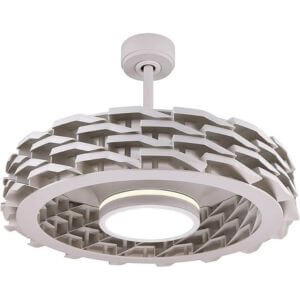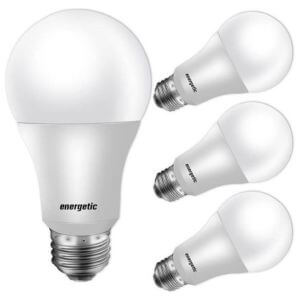Do you pay too much for electricity? If you’re like me, you already take steps to conserve energy – but the bills keep rising. How can you lower your summer energy bills without sacrificing comfort?
Summertime means higher temperatures and humidity levels, and this can translate into higher-than-usual energy bills. This summer, inflation is also “hot and sticky,” and this can impact electricity prices.
While you can’t control the weather or inflation, you can do things to conserve energy and save money. Today, we’ll look at 10 ways to lower your summer energy bills, even in the hottest months of the year.
Let’s get started.
📋 DISCLOSURE – This page has affiliate links. If you buy something through one of these links, I may earn a commission at no cost to you. Read more here.
Welcome to the Dog Days of Summer
Last week, I opened our electricity bill and winced. It was much higher than our typical bills, which are pretty reasonable for our small apartment home. Even in Florida.
Welcome to the dog days of summer!
{ Update: Our new house has energy-efficient windows and appliances, which have reduced our electricity bills. But that doesn’t mean we’ve stopped looking for ways to save money. Household savings are always good. }
The dictionary defines dog days as the time “between early July and early September, when the hot, sultry [summer months] occur in the Northern Hemisphere.”
Did you know cooling your home accounts for 50% to 70% of your summer energy use? Thankfully, there are ways to stay cool AND save money.
Here are 10 of them.
How to Cut Your Summer Energy Bills
The dog days may bite your wallet, but they don’t have to bust your budget. You can save energy, cut electricity costs, and still have a comfortable home.
Here are 10 ways to lower your summer energy bills without sacrificing comfort.
1. Raise the Thermostat
Your air conditioner plays a HUGE role in summer energy costs. To save money this summer, set your thermostat to 78 degrees when you’re at home, and somewhat higher when you’re away.
“For every degree you increase your thermostat, you can save about 5% on your monthly cooling costs,” said Duke Energy. Five percent may not seem like a lot, but every dollar counts.
Is 78 degrees too warm for comfort? Use house fans to move the cool air through your home. And drink more water. Not only does water cool you down, it also improves your health.
2. Program the Thermostat
A programmable thermostat changes your temperature settings at predetermined times. For example, you can set it to change the temperature when you leave for work, return home, and go to bed.

We swapped the standard apartment thermostat for an inexpensive Honeywell model from Walmart. But there are models with all kinds of extras online.
Some thermostats have smart features like touch screens and wireless remote access. If you’re willing to spend more for these features, this WiFi thermostat is one to consider.
Some power companies provide FREE programmable thermostats for their residential customers. For example, CPS Energy installs smart thermostats for qualified customers. Contact your electric company to see if you qualify for a free model.
3. Change the Filters
Clean or replace your air filter at least once a month. A dirty filter puts a strain on your cooling system, causing it to run harder and longer. Not only does this increase your energy bill, but it also shortens the life of your air conditioner.
The maintenance staff changes the filter in our apartment unit, but we don’t have to wait for him. I usually request a new filter when I make a monthly rent payment. Whether you rent or own your home, don’t overlook this easy way to cut your summer energy bills.
{ Update: We replace the filters in our home every three months. A large one in the living room and a small one in our bedroom. Click here to shop for 90-day filtration filters. }
4. Turn On the Fans
Attic and ceiling fans are good supplements to your home’s air conditioning. They circulate the air and make your home feel cooler, so the thermostat can stay at a higher setting.

Our new house has five rooms (plus a screened-in lanai) that are pre-wired for ceiling fans. We’re shopping for the perfect models.
This bladeless ceiling fan is also a light fixture. It’s too modern for our décor, but it looks interesting. What do YOU think?
We use fans all summer long and rarely set the thermostat below 78 degrees. It feels pleasant indoors, even for me.
When it gets too warm for comfort, I turn on my tower fan. It’s a lifesaver when my “personal thermostat” is out of whack. Oh, the joys of midlife!
5. Turn Off the Electronics
Turn off your electronic devices – or anything that uses electricity – when not in use. Your television, stereo, game console, computer, phone charger, digital camera. And don’t forget about the fans, lamps, and small kitchen appliances.
Better yet, unplug the devices when they’re not in use. Even turned off, they can leak electricity as standby power. Experts call this leakage “phantom load” or “vampire energy.” Power strips make it easy to turn off several devices at once, or you can just unplug the power strip.
Click here to shop for top-rated surge protected power strips.
6. Replace the Light Bulbs
The electric current in a standard incandescent bulb heats a thin filament to make the bulb glow. The light is soft and warm, but the bulb loses most of its energy in heat. A compact fluorescent light (CFL) bulb (the “curly” one) is an energy saving alternative.
The electric current in a CFL bulb energizes gas vapors, which cause the bulb’s phosphor coating to glow. While this bulb emits a brighter light, it uses less energy and loses very little heat.

Light emitting diodes (LED) are even better energy savers. They’re longer and more traditional looking. They produce light when an electric current passes through the bulb.
LED bulbs have an amazing lifespan – up to 50,000 hours! They’re also durable and less likely to break than CFL bulbs.
Both options are better energy savers than standard bulbs. But we prefer using LED light bulbs in our home. Here’s why.
Light emitting diodes cost more than compact fluorescent lamps. But they save you money in the long run. CFL bulbs use 25% less energy than traditional bulbs, but LED bulbs use 75% less!
As our light bulbs burn out, we replace them with LED light bulbs. They’re clear winners in the long run – for energy efficiency, lifespan, and cost.
{ Note: An incandescent light bulb ban went into effect August 1, 2023, forcing Americans to buy more efficient bulbs to save energy and cut carbon emissions. Read more here. }
7. Use Less Hot Water
Here is a practical way to lower your your energy bills: Use less hot water. When you wash the dishes, for example, or do the laundry, or take a shower. Use the lowest recommended setting to wash clothes, and bathe or shower in warm (not hot) water.
If your tap water is too hot, lower the water heater thermostat to 120 degrees. Another way to save: run shorter cycles on your washing machine, dryer, and dishwasher. Consider installing low-flow shower heads and faucet aerators.
8. Close the Curtains
Window coverings are part of your home décor. They insulate your rooms to keep them cool in the summer and warm in the winter. Let your drapes and curtains hang loose, and make sure they don’t block the return air vents.
Close the curtains, draw the drapes, shut the blinds, and pull the shades where sunlight pours into a room. Especially during the hottest time of the day. This keeps the sun from heating the room. Window caulking and weather stripping keep the cool air from escaping.
{ We love our linen curtains from World Market. The soft gray leaf pattern looks nice against our greige walls. They are no longer available, but Amazon sells similar linen blend curtains from Exclusive Home Curtains.
By the way, our wall color is Accessible Beige from Sherwin Williams. You can find a comparable match from Prestige Paints here. }
9. Rest the Pool Pump
Water movement is essential for a clean swimming pool. But don’t run the pump on a constant basis. Set the timer and run it during the day, and only for the recommended time.
According to Duke Energy, single-speed pumps can make up 20% of your total energy bill. Only your air conditioner uses more electricity during the summer months.
Is your pool pump a single-speed model, or is it more than seven years old? If so, replace it with a variable speed model to reduce your summer energy costs.
10. Fire Up the Grill
Do you spend a lot of time working in the kitchen? Cooking and baking creates a huge amount of heat, especially in a smaller kitchen like ours.
Use an outdoor grill for summer barbecues, or prepare simple meals that don’t need cooking or baking. Besides saving energy and money, outdoor grilling is a great way to keep your home’s kitchen shiny and clean.
Conclusion
That’s it – 10 ways to lower your summer energy bills without sacrificing comfort. For more tips on how to stay cool and save money, check out the comments section below. Feel free to share YOUR tips, too.
Don’t let the dog days get you down. Stay cool, and have a safe and happy summer. ◻️
Related Posts
- 5 Ways to Get Your Swimming Pool Ready for Summer Fun
- 28 Budgeting Tools to Help You Manage Your Money
- How to Manage Your Money Better: 7 Tips for Couples

Now It’s Your Turn
Thank you for reading my post. Now it’s YOUR turn to chime in. How do YOU cut your summer energy bills without sacrificing comfort? Which tips above will you apply this month?
Let’s fill the comments with friendly conversation. Scroll down to leave a reply, ask a question, or just say hello. And if you liked this post, please give it a share.
Blessings, Annette
📋 NOTE – You are reading “10 Good Ways to Lower Your Summer Energy Bills” on Savoring Home. First published in June 2020, it was updated in August 2023.
Photo Sources
- Josh Newman | Flickr | License

Yes, such a thing as a dirty air conditioner filter can decrease a home’s energy efficiency. We should remember to replace filters once every 60-90 days. In addition to improved HVAC system efficiency, it contributes to better indoor air quality.
We try to replace our filters every 90 days to improve efficiency and air quality. Thank you for the reminder.
According to this source, it is also not recommended to blast your AC 24/7. Otherwise, this will result in large bills. Using fans to distribute air and keep the house cooler is actually a good idea.
Thanks for the comment – a good reminder for those of us who want to save energy and money this summer. We set the AC higher than most, I suppose. Just enough to remove the humidity during the hot Florida summer. We also use fans to circulate the air. What’s more, our home has energy-efficient windows, which keeps things a lot cooler.
Thank you for sharing such great and helpful tips, Annette!
As an addition to all your tips, I want to share our article with some other ways to reduce summer energy bills: Top 5 Ways to Reduce Air Conditioning This Summer
Hopefully, someone will find it helpful 🙂
You’re welcome, Tay. I appreciate your comment and tips. Thanks for stopping by.
Also, consider inspecting your air ducts regularly and sealing leaks if needed. Properly sealed air ducts make your HVAC system work more efficient and also improve your indoor air quality.
Thank you for this tip.
In addition to replacing air conditioner filters, remember to routinely drain the lines and clean the coils. It is important for not only preventing increased energy consumption but avoiding potential AC repairs down the road.
Great tip, Olivia. Just this week, our AC was “acting up” because the drain line was clogged. Despite using a wet/dry vacuum cleaner and trying to clear it ourselves, we finally had to call our local AC repair company to unclog the line. He said it was a good idea to use the vacuum every other month to keep the line from clogging again.
Yes!!! But also, remember to remove debris from your air conditioning unit – this is an important part of AC maintenance. Dirt and grime on AC coils makes it harder for your equipment to transfer heat. That means it has to run longer and work harder to do it’s job, using more energy and causing parts to wear and break down.
Hi, Regina. Thanks for sharing this energy- and money-saving tip with us.
Yes, clean filters are crucial for energy-efficient AC performance. However, other things like cleaning the coils, clearing the clutter around air vents, and unclogging the condensate drain tube should also be kept in mind. Regular AC tune-up can save you up to 15% on your power bill each month.
Thank you, Ace. All great tips!
One more thing to consider in order to reduce energy consumption is letting your air conditioner run when you leave your house in the morning. It may seem counterintuitive, however, by setting your air conditioner at a sensible 72 degrees before you leave for the day, you will be able to come home to a comfortable house without having to crank the AC as low as it goes as soon as you step through the door.
Thanks for the tip. The air conditioner stays on when we leave the house, but we set it a little higher than 72 degrees. (We’re older, and we don’t like it that cold!) Leaving the AC on keeps our house comfortable and helps with the humidity, especially during Florida’s rainy season (May through October).
Thank you for these tips! Investing in variable speed pool pumps is undeniably a wise choice. They also bring forth a range of valuable advantages, including quiet operation, enhanced water clarity, and lower environmental impact.
You’re welcome. Your tip is a good one, too – and something that’s not covered in the post. Thanks for sharing!
Thank you for these tips! And also to cut your summer energy bills, keep your windows closed during the day and utilize light-colored or reflective window treatments to block out direct sunlight. Additionally, sealing any air leaks around your windows will enhance energy efficiency and reduce the need for excessive cooling.
All great tips, and the timing is perfect as we head into summer. Thanks so much for stopping by.
Lowering your summer energy bills by improving the energy efficiency of your doors is one more practical way to save money and reduce your environmental footprint. For instance, consider to attach door sweeps to the bottom of exterior doors. They create an additional barrier against drafts and help keep conditioned air inside.
Another great tip. Thanks for sharing it here!
Such a thing as keeping cold air inside the house will also help you reduce your energy bills. Odds are your house is letting cold air out even without the door open. Wall insulation is key, but you can also caulk around windows and add insulation around doors. Stand outside your house when the A/C is running and run your hand along closed doors and windows to feel any potential escaping cold air.
Great tip! We try not to keep our doors open for long – including the slider that opens into our screened lanai. But we’ll make sure to check our closed doors and windows for escaping air.
Using a smart thermostat is actually a good way to reduce energy bills. According to real-world data gathered by the Environmental Protection Agency, smart thermostats that meet Energy Star criteria save users an average of 8% on their utility bills. Thanks for sharing the tips for using it effectively.
You’re welcome – and thanks for sharing some real-world data. Smart thermostats are the way to go for energy- and money-savings.
It’s also worth remembering that running an air conditioner that isn’t working well can make your utility bills higher. So, don’t forget to check it before the hot weather arrives and fix any problems. Keep an eye out for signs that your AC might be failing, like warm air blowing, inconsistent cooling, strange noises or smells, coolant leaks, the system turning on and off quickly, or not responding to the thermostat. If you notice any of these signs, it’s best to schedule an emergency service appointment.
Excellent reminders as we head into summer. By the way, I see you’re in San Antonio. We moved to Florida from northwest San Antonio. I miss the rolling hills, vibrant culture, and historic downtown. Thanks again for your comment.
San Antonio is really a wonderful city with a special vibe. You’re welcome!
Thanks for letting us know about the best temperature for summer savings at home. I’ve got something extra to share with your readers: a sample cooling schedule they can use to program their thermostats. It covers different situations like being home, away, or sleeping. They can find it here: https://www.dashservice.com/save-energy.
You’re welcome. And I appreciate the sample cooling schedule. Thanks!
To maximize energy efficiency and save money, consider upgrading to an energy-efficient hot-water system, such as a tankless water heater. The US Department of Energy states that tankless water heaters save you money because they “don’t produce the standby energy losses associated with storage water heaters.” Find out about all the benefits of tankless water heaters: https://acehomeco.com/benefits-of-tankless-water-heaters/.
Good to know. I’m off to read more about tankless water heaters!
Also, I want to suggest considering switching to solar energy. It is a great way to make your home more energy-efficient and reduce energy bills. Even though the upfront cost of installing solar panels can be a major barrier to transitioning to solar energy, homeowners and businesses have access to solar incentives such as solar tax credits that significantly reduce installation expenses.
Good tip. Thanks for the suggestion.
Great article with fantastic tips! Additional suggestion that can help save on your summer energy bills is to insulate your hot water pipes. By wrapping your pipes with foam insulation, you can reduce heat loss, which means your water heater doesn’t have to work as hard to keep water hot. This simple DIY project can help lower your energy consumption and reduce your electricity bills, especially during the peak summer months. It’s an easy and cost-effective way to improve your home’s energy efficiency.
Thanks, Andrew, for this excellent energy- and money-saving tip. Yet another way we can lower our summer energy bills and save money, which is so important in today’s economy. Enjoy the summer!
Really appreciate how this breaks everything down into practical steps. One thing I’d add—especially if you have a pool—is looking at energy-efficient upgrades there too. We switched to a robotic pool cleaner last summer, and it made a noticeable difference in our energy use and bills. It runs on low power and cleans more efficiently than our old system, so the pump doesn’t have to work overtime.
Thanks, John. Great tip! And here are more tips to make your pool swim ready and safe for summer.